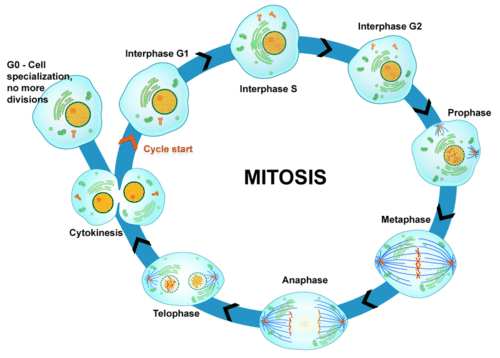2.13: Mitosis
- Page ID
- 13314
\( \newcommand{\vecs}[1]{\overset { \scriptstyle \rightharpoonup} {\mathbf{#1}} } \)
\( \newcommand{\vecd}[1]{\overset{-\!-\!\rightharpoonup}{\vphantom{a}\smash {#1}}} \)
\( \newcommand{\id}{\mathrm{id}}\) \( \newcommand{\Span}{\mathrm{span}}\)
( \newcommand{\kernel}{\mathrm{null}\,}\) \( \newcommand{\range}{\mathrm{range}\,}\)
\( \newcommand{\RealPart}{\mathrm{Re}}\) \( \newcommand{\ImaginaryPart}{\mathrm{Im}}\)
\( \newcommand{\Argument}{\mathrm{Arg}}\) \( \newcommand{\norm}[1]{\| #1 \|}\)
\( \newcommand{\inner}[2]{\langle #1, #2 \rangle}\)
\( \newcommand{\Span}{\mathrm{span}}\)
\( \newcommand{\id}{\mathrm{id}}\)
\( \newcommand{\Span}{\mathrm{span}}\)
\( \newcommand{\kernel}{\mathrm{null}\,}\)
\( \newcommand{\range}{\mathrm{range}\,}\)
\( \newcommand{\RealPart}{\mathrm{Re}}\)
\( \newcommand{\ImaginaryPart}{\mathrm{Im}}\)
\( \newcommand{\Argument}{\mathrm{Arg}}\)
\( \newcommand{\norm}[1]{\| #1 \|}\)
\( \newcommand{\inner}[2]{\langle #1, #2 \rangle}\)
\( \newcommand{\Span}{\mathrm{span}}\) \( \newcommand{\AA}{\unicode[.8,0]{x212B}}\)
\( \newcommand{\vectorA}[1]{\vec{#1}} % arrow\)
\( \newcommand{\vectorAt}[1]{\vec{\text{#1}}} % arrow\)
\( \newcommand{\vectorB}[1]{\overset { \scriptstyle \rightharpoonup} {\mathbf{#1}} } \)
\( \newcommand{\vectorC}[1]{\textbf{#1}} \)
\( \newcommand{\vectorD}[1]{\overrightarrow{#1}} \)
\( \newcommand{\vectorDt}[1]{\overrightarrow{\text{#1}}} \)
\( \newcommand{\vectE}[1]{\overset{-\!-\!\rightharpoonup}{\vphantom{a}\smash{\mathbf {#1}}}} \)
\( \newcommand{\vecs}[1]{\overset { \scriptstyle \rightharpoonup} {\mathbf{#1}} } \)
\( \newcommand{\vecd}[1]{\overset{-\!-\!\rightharpoonup}{\vphantom{a}\smash {#1}}} \)
\(\newcommand{\avec}{\mathbf a}\) \(\newcommand{\bvec}{\mathbf b}\) \(\newcommand{\cvec}{\mathbf c}\) \(\newcommand{\dvec}{\mathbf d}\) \(\newcommand{\dtil}{\widetilde{\mathbf d}}\) \(\newcommand{\evec}{\mathbf e}\) \(\newcommand{\fvec}{\mathbf f}\) \(\newcommand{\nvec}{\mathbf n}\) \(\newcommand{\pvec}{\mathbf p}\) \(\newcommand{\qvec}{\mathbf q}\) \(\newcommand{\svec}{\mathbf s}\) \(\newcommand{\tvec}{\mathbf t}\) \(\newcommand{\uvec}{\mathbf u}\) \(\newcommand{\vvec}{\mathbf v}\) \(\newcommand{\wvec}{\mathbf w}\) \(\newcommand{\xvec}{\mathbf x}\) \(\newcommand{\yvec}{\mathbf y}\) \(\newcommand{\zvec}{\mathbf z}\) \(\newcommand{\rvec}{\mathbf r}\) \(\newcommand{\mvec}{\mathbf m}\) \(\newcommand{\zerovec}{\mathbf 0}\) \(\newcommand{\onevec}{\mathbf 1}\) \(\newcommand{\real}{\mathbb R}\) \(\newcommand{\twovec}[2]{\left[\begin{array}{r}#1 \\ #2 \end{array}\right]}\) \(\newcommand{\ctwovec}[2]{\left[\begin{array}{c}#1 \\ #2 \end{array}\right]}\) \(\newcommand{\threevec}[3]{\left[\begin{array}{r}#1 \\ #2 \\ #3 \end{array}\right]}\) \(\newcommand{\cthreevec}[3]{\left[\begin{array}{c}#1 \\ #2 \\ #3 \end{array}\right]}\) \(\newcommand{\fourvec}[4]{\left[\begin{array}{r}#1 \\ #2 \\ #3 \\ #4 \end{array}\right]}\) \(\newcommand{\cfourvec}[4]{\left[\begin{array}{c}#1 \\ #2 \\ #3 \\ #4 \end{array}\right]}\) \(\newcommand{\fivevec}[5]{\left[\begin{array}{r}#1 \\ #2 \\ #3 \\ #4 \\ #5 \\ \end{array}\right]}\) \(\newcommand{\cfivevec}[5]{\left[\begin{array}{c}#1 \\ #2 \\ #3 \\ #4 \\ #5 \\ \end{array}\right]}\) \(\newcommand{\mattwo}[4]{\left[\begin{array}{rr}#1 \amp #2 \\ #3 \amp #4 \\ \end{array}\right]}\) \(\newcommand{\laspan}[1]{\text{Span}\{#1\}}\) \(\newcommand{\bcal}{\cal B}\) \(\newcommand{\ccal}{\cal C}\) \(\newcommand{\scal}{\cal S}\) \(\newcommand{\wcal}{\cal W}\) \(\newcommand{\ecal}{\cal E}\) \(\newcommand{\coords}[2]{\left\{#1\right\}_{#2}}\) \(\newcommand{\gray}[1]{\color{gray}{#1}}\) \(\newcommand{\lgray}[1]{\color{lightgray}{#1}}\) \(\newcommand{\rank}{\operatorname{rank}}\) \(\newcommand{\row}{\text{Row}}\) \(\newcommand{\col}{\text{Col}}\) \(\renewcommand{\row}{\text{Row}}\) \(\newcommand{\nul}{\text{Nul}}\) \(\newcommand{\var}{\text{Var}}\) \(\newcommand{\corr}{\text{corr}}\) \(\newcommand{\len}[1]{\left|#1\right|}\) \(\newcommand{\bbar}{\overline{\bvec}}\) \(\newcommand{\bhat}{\widehat{\bvec}}\) \(\newcommand{\bperp}{\bvec^\perp}\) \(\newcommand{\xhat}{\widehat{\xvec}}\) \(\newcommand{\vhat}{\widehat{\vvec}}\) \(\newcommand{\uhat}{\widehat{\uvec}}\) \(\newcommand{\what}{\widehat{\wvec}}\) \(\newcommand{\Sighat}{\widehat{\Sigma}}\) \(\newcommand{\lt}{<}\) \(\newcommand{\gt}{>}\) \(\newcommand{\amp}{&}\) \(\definecolor{fillinmathshade}{gray}{0.9}\)
How is your DNA organized?
Your DNA is organized into chromosomes, the pink structures pictured above. Your DNA doesn't always look so pretty, though. It only winds tightly into chromosomes when the cell is getting ready to divide. If your DNA wasn't organized into chromosomes, your DNA would look like a mass of strings and would be difficult to divide up!
Mitosis and Chromosomes
The genetic information of the cell, or DNA, is stored in the nucleus. During mitosis, two nuclei (plural for nucleus) must form, so that one nucleus can be in each of the new cells after the cell divides. In order to create two genetically identical nuclei, DNA inside of the nucleus must be copied or replicated. This occurs during the S phase of the cell cycle. During mitosis, the copied DNA is divided into two complete sets, so that after cytokinesis, each cell has a complete set of genetic instructions.
Chromosomes
To begin mitosis, the DNA in the nucleus wraps around proteins to form chromosomes. Each organism has a unique number of chromosomes. In human cells, our DNA is divided up into 23 pairs of chromosomes. Replicated DNA forms a chromosome made from two identical sister chromatids, forming an "X" shaped molecule (Figure below). The two chromatids are held together on the chromosome by the centromere. The centromere is also where spindle fiber microtubules attach during mitosis. The spindles separate sister chromatids from each other.

Four Phases of Mitosis
During mitosis, the two sister chromatids must be divided. This is a precise process that has four individual phases to it. After the sister chromatids separate, each separate chromatid is now known as a chromosome. Each resulting chromosome is made of DNA from just one chromatid. So, each chromosome after this separation is made of "1/2 of the X." Through this process, each daughter cell receives one copy of each chromosome. The four phases of mitosis are prophase, metaphase, anaphase and telophase (Figure below).
- Prophase: The chromatin, which is unwound DNA, condenses forming chromosomes. The DNA becomes so tightly wound that you can see them under a microscope. The membrane around the nucleus, called the nuclear envelope, disappears. Spindles also form and attach to chromosomes to help them move.
- Metaphase: The chromosomes line up in the center, or the equator, of the cell. The chromosomes line up in a row, one on top of the next.
- Anaphase: The two sister chromatids of each chromosome separate as the spindles pull the chromatids apart, resulting in two sets of identical chromosomes.
- Telophase: The spindle dissolves and nuclear envelopes form around the chromosomes in both cells.

After telophase, each new nucleus contains the exact same number and type of chromosomes as the original cell. The cell is now ready for cytokinesis, which literally means "cell movement." During cytokinesis, the cytoplasm divides and the parent cell separates, producing two genetically identical cells, each with its own nucleus. A new cell membrane forms and in plant cells, a cell wall forms as well. Below is a representation of dividing plant cells (Figure below).

Summary
- The DNA in the nucleus wraps around proteins to form chromosomes.
- During mitosis, the newly duplicated chromosomes are divided into two daughter nuclei.
- Mitosis occurs in four phases, called prophase, metaphase, anaphase, and telophase.
Explore More
Use the resource below to answer the questions that follow.
- Mitosis by NDSU VCell Productions at http://www.youtube.com/watch?v=C6hn3sA0ip0 (6:10)
- When does the "classic" chromosome structure of DNA appear during mitosis?
- What problems do you think might arise if the chromosomes did not align during metaphase?
- When do the nuclear envelopes reform? What problems might arise if a cell started forming the nuclear envelopes earlier?
- In what stage do cells spend most of their "life"?
- How long does mitosis take in the typical eukaryotic cell?
Review
- What are chromosomes?
- What are the four phases of mitosis, in the correct order?
- In what phase of mitosis are chromosomes moving toward opposite sides of the cell?
- Compare the two nuclei that form as a result of mitosis?
- What is cytokinesis, and when does it occur?

